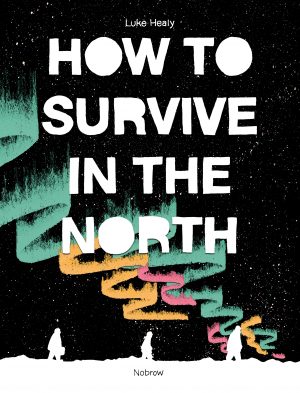Why is it that stories of Arctic exploration are so endlessly compelling? Well, it’s because they manage to hit so many dramatic points all at once: survival, endurance, tragedy, hubris, cunning, and heroism. They’re good stories because you can find a little bit of everything in them, or if you’re looking for some particular theme or emotion, they can be a treasure trove. How to Survive in the North looks at two real-life stories that happened at the same place, Wrangel Island, in 1914 and 1921, and the impact that those two stories had on a man going through a mid-life crisis.
Sullivan Barnaby is a professor at Dartmouth University forced into a mandatory sabbatical after a scandal compromises his position as a teacher. Left with nothing to do, he stumbles across the letters of a former professor, Vilhjalmur Stefansson. Stefansson believed that people could survive nearly indefinitely on meat and blubber, and sponsored two expeditions to Wrangel Island, one in 1914 and one in 1921. Both of these expeditions ran into trouble because of inadequate preparations and rash planning, and it fell to two different people, Robert Barnett and Ada Blackjack, to try and hold everything together. By going through these two stories, Barnaby begins to understand how survival in the face of doom might have lessons for his own life.
 To be honest, I was a sucker for this story from the get-go. I grew up on the stories of Ernest Shackleton, intoxicated by the idea of surviving something that would kill just about anybody else (myself included). The fact that this book tells not one but two of those kinds of stories, both appropriately grounded in the history, is an easy way to win me over. The improbable coincidence that Wrangel Island became home to two expeditions, both sponsored by the same man, with one of the same men in both, is just too good. Robert Barnett’s trip across the ice of the Bering Sea to find help sounds like an impossible feat; so does Ada’s survival, considering that she had no training as a hunter or explorer. The fact that it’s also about an academic who stumbles across a riveting story hits a little close to home for me.
To be honest, I was a sucker for this story from the get-go. I grew up on the stories of Ernest Shackleton, intoxicated by the idea of surviving something that would kill just about anybody else (myself included). The fact that this book tells not one but two of those kinds of stories, both appropriately grounded in the history, is an easy way to win me over. The improbable coincidence that Wrangel Island became home to two expeditions, both sponsored by the same man, with one of the same men in both, is just too good. Robert Barnett’s trip across the ice of the Bering Sea to find help sounds like an impossible feat; so does Ada’s survival, considering that she had no training as a hunter or explorer. The fact that it’s also about an academic who stumbles across a riveting story hits a little close to home for me.
But it goes a bit deeper than just recounting an admittedly gripping story by giving us Barnaby’s perspective. Barnaby’s life is empty once he’s separated from his work, and apart from a profoundly troubled relationship he’s as alone as Robert or Ada. His immediate parallel in the tale is Stefansson, whose office he shares. Stefansson was a man who seemingly became addicted to a bad idea (easy living in the far north) and kept trying to make it work, even though his expeditions lacked what they needed to survive. Overconfidence and commitment to a cause can be a dangerous combination, and Barnaby gradually learns from Stefansson that you need to recognize when a bad idea is a bad idea.
Indeed, you could read a lot of this story as a warning to people to recognize when a situation is dangerous. Both Robert and Ada have misgivings about their respective expeditions, but go along with them anyway. Fred Maurer, one of the sailors in the 1914 expedition, returns for the 1921 expedition. Why? Surely he knew exactly how dangerous it would be, probably much better than Stefansson, but he let himself get talked into it by Stefansson because he was “a nice guy.”
If on the one hand the story is critical of its protagonists for going along with something they knew could work out badly, it also is a reminder that loneliness isn’t such a bad thing. There are a multitude of reasons why so many people seemingly become addicted to Arctic exploration (people beyond the scope of this story, like Robert F. Scott or Roald Amundsen): challenge, the thrill of survival, a determination to make a name for themselves…But there’s also something about being alone with yourself that ends up being weirdly invigorating for some of the characters here. It’s not to say that running away from other people is the ticket to survival, because people who do that in this book end up dead. But knowing when to rely on yourself is its own strength, which harkens back to why these stories are interesting in the first place.
This is a worthwhile read, both because of the story and its meta-story about loneliness and endurance. This is the kind of historical fiction I want to see people writing, because it also challenges the reader to understand why they find it compelling in the first place.
[su_box title="Score: 5/5" style="glass" box_color="#8955ab" radius="6"]
How to Survive in the North
Writer: Luke Healy
Artist: Luke Healy
Publisher: Nobrow Comics
Price: $22.95
Format: TPB
[/su_box]














